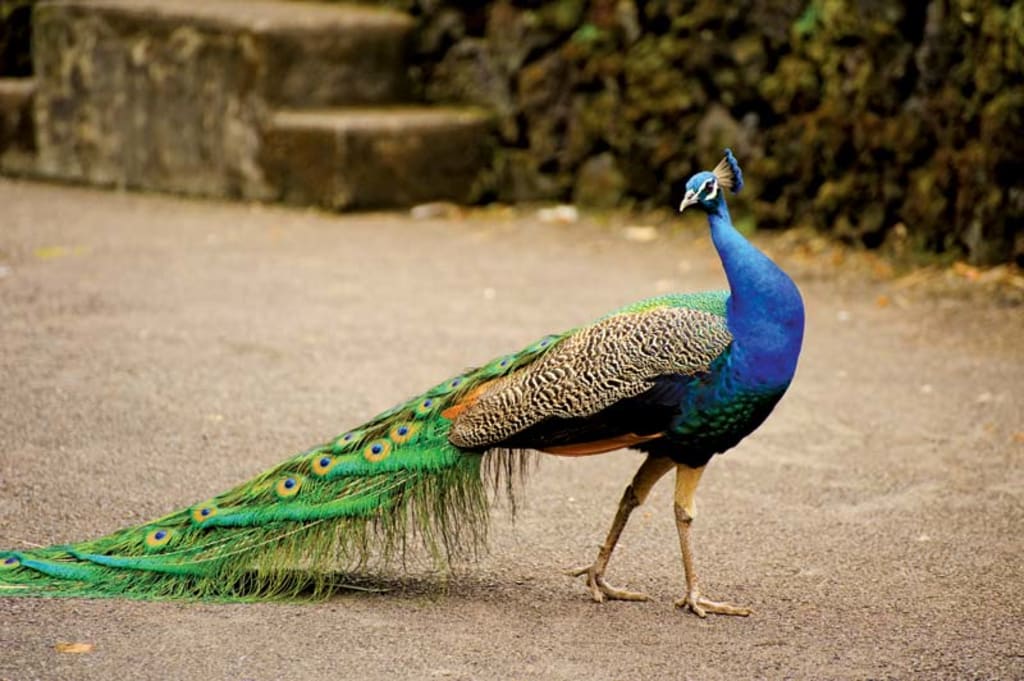
Much like male chickens are often referred to as ‘cocks’, peacock refers to the male members of species collectively known as peafowl. Males are indeed distinctive and are well-known for their colorful feather-fan near their rump that they often open in displays for females. These feathers are very colorful and iridescent, featuring shimmering shades of bright green, blue, and white. When not spread out, these feathers follow the male in a ‘train’ about two thirds the length of the bird itself. Excluding this, peacocks grow to 70-98 in (140-160 cm) long and weigh 8-13 lb (3.8-6 kg).Distribution and Habitat
There are three species of peafowl. The Indian peafowl (Pavo cristatus) is native to the Indian subcontinent and is also known as the common peacock or common peafowl. The green peafowl (Pavo muticus) is native to southeast Asia and the Congo peafowl (Afropavo congensis) is endemic to the Congo Basin of Africa.
Within their ranges, peacocks prefer forested areas. Here, they will use trees as a refuge and roosting area, retreating to them in the night to avoid predators. In the mornings, peafowl emerge from their roosts to spend the day in clearings in search of food.Diet and Predators
All peafowl species are omnivores, subsisting on mostly plant material such as flower petals and seeds. Peafowls also eat animals such as insects, small reptiles, and amphibians. They will spend their days walking around the open areas searching through the leaf litter and other debris. They use their beaks to move items out of the way and scratch at the dirt in search of anything edible. Typically, peafowl retreat to forests during the hottest part of the day to avoid the heat.Nesting and Reproduction
Peafowl normally build nests on the ground. They will scrape out a small depression in the ground and line it with grass and other soft vegetation where available. Typically these nests are concealed under bushes or in high grass. Peafowl are polygamous, mating with multiple mates. Males will use their covert tail feathers in a courtship display in an attempt to attract a mate. During this performance, males will often shake their feathers and peck at the ground as if it were feeding.
Following copulation, females typically lay between 2-10 eggs. After about 4 weeks of incubation, chicks are born with cryptic plumages, typically varying between yellow and other shades of brown. These chicks will remain with their mothers for about 7-10 weeks for striking out on their own. However, most peafowl will not become sexually mature until between 2-3 years. By this point, they have grown into their adult plumage, although some mails require about 4 years to fully develop their tail feathers that make up their infamous ‘fan’.Conservation
The common peafowl is listed as least concern on the IUCN Red List. Not only is the species somewhat common in the wild, but it is very popular in aviaries around the world. The green peafowl, however, is listed as Endangered since 2009 while the Congo peafowl is listed as Vulnerable, with just 2 500-9 000 individuals remaining in the Congo basin in 2013. Some peacocks have been observed to make use of secondary-growth forests, which may point to a potential conservation strategy for the species as old-growth forests become increasingly rare, threatening countless species around the world.Sexual Selection
The colorful tail feathers of the peacock have long been held up as an example of sexual selection, a form of natural selection postulated by Charles Darwin in which certain traits evolve because they are selected for by mates and thus sexually selected for. The theory suggests that this selection promotes the maintenance of these traits in the population.
However, a more recent theory referred to as the handicap theory has also been proposed. In this theory, researchers suggest that the feathers are actually a hindrance that requires exceptionally fit males to overcome. They refer to this as a ‘true sign’ of fitness, a particular variation on the classic theory of sexual selection. This is referred to as a potential ‘missing piece’ to Darwin’s puzzle.





Comments
There are no comments for this story
Be the first to respond and start the conversation.